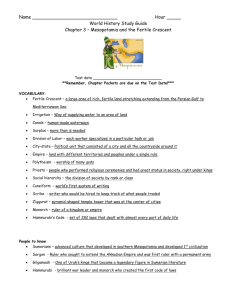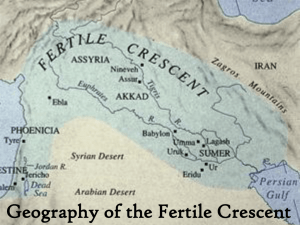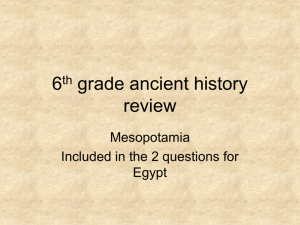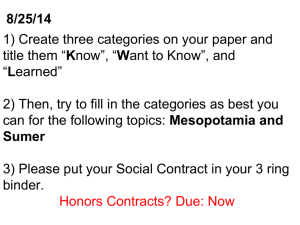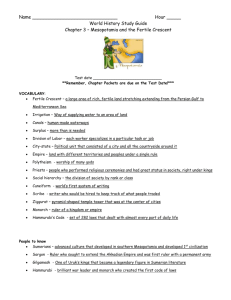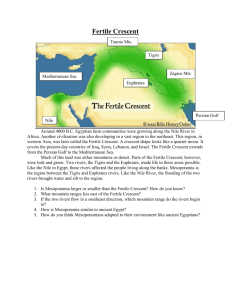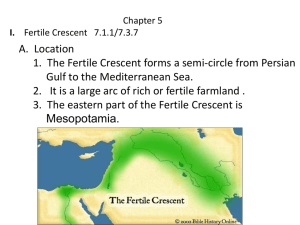WHICh2Sec3Sumer-2014
advertisement
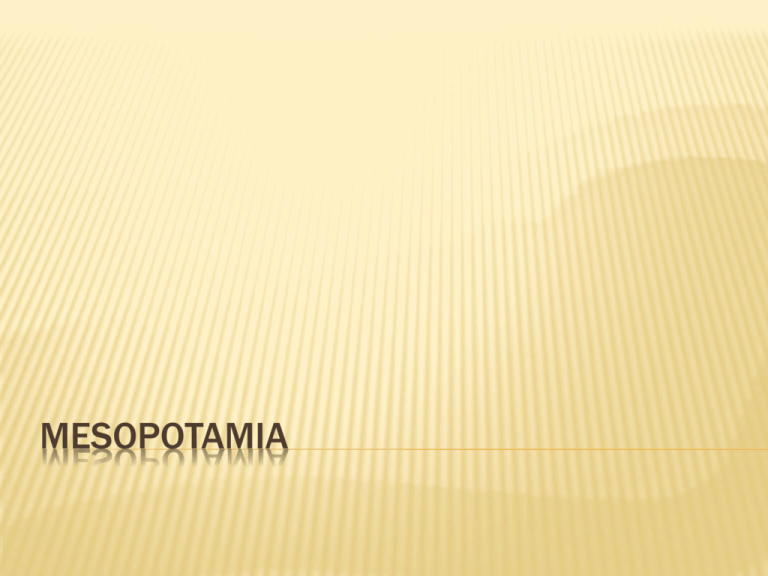
MESOPOTAMIA FERTILE CRESCENT & MESOPOTAMIA Fertile crescent-a crescent shaped strip of fertile land that includes the eastern coast of the Mediterranean and arcs through Southwest Asia Mesopotamia-the land between the Tigris and Euphrates Rivers Mesopotamia forms the eastern part of the fertile crescent Fertile Crescent Mesopotamia Tigris River Euphrates River Mediterranean Sea Red Sea Persian Guls Nile River Black Sea Caspian Sea TIGRIS & EUPHRARATES The Tigris and Euphrates are the major geographical feature of the Fertile Crescent and Mesopotamia. In Mesopotamia, the Tigris and Euphrates begin in the hills of Asia Minor (Turkey) and flow southeast into the Persian Gulf Like the Nile, the Tigris and Euphrates flooded often, usually once a year. Like the Nile, the flood of the T. & E. brought rich soil. Unlike the Nile flood, the time of the flooding of the T. & E. could not be easily predicted. It could come anytime between the beginning of March and the end of June. Unlike the Nile flood, the amount of the flood of the T & E was unpredictable, and it could be violent and sudden. FERTILE CRESCENT & MESOPOTAMIA Perhaps because their rivers were harsher and less predictable than the Nile, the people of Mesopotamia saw nature & the gods as harsh and unpredictable The people of Mesopotamia had to cooperate dikes to control the flood and irrigation ditches to bring water to their crops in the dry season. Irrigation & dike building required cooperation & organization. Cooperation & organization pushed them toward civilization CONQUEST, EMPIRES & CHANGE Like the Nile Valley, the land surrounding Mesopotamia & the Fertile Crescent was dry. However, it was not as dry and barren as the land around Egypt. It was not geographically isolated. Tribes of wandering herders lived in this dry land and often invaded the fertile valleys, conquered them & created empires. Then these invaders grew weak and new invaders conquered them. The early history of the Fertile Cres. & Mesopotamia involves repeated migration & conquest. Whereas the history of Egypt is the story of one people in one place, the history of the Fertile Cresc & Mesopotamia is the story of conquest, empires & & change “The invading herders have set fire to the crop lands surrounding several Sumerian villages. They have carried away the Silver and precious stones. They have shed blood in the palace of the ruler. They have removed the grain from the fields and villages, all of it that was under cultivation.” Like the Nile, the Tigris & Euphrates brought rich soil (silt) when they flooded. The lower (southeastern) part of Mesopotamia had especially rich soil. This part came to be called Sumer. Early accomplishments: By about 3100BC, the people of Sumer used bronze Writing CUNEIFORM The pictographs of the Sumerians, which evolved into a type of writing called cuneiform. This was probably the world’s first form of writing. It probably began about 3100BC. These pictographs evolved from an earlier system of using small clay tokens to represent things. These tokens were placed on clay jars like labels. CUNEIFORM Both cuneiform and hieroglyphics started as pictographs. Sumerian writing was inscribed on wet clay tablets with a sharp reed called a stylus. (unlike hieroglyphics, which was carved on stone or written on papyrus. The early pictographs of Sumer soon became simplified into wedge-shaped symbols (cuneus means wedge-shaped). The Sumerians had about 600 cuneiform signs. Eventually, many different languages in the Middle East were written in cuneiform. ARCHITECTURE The Sumerians may have invented architectural designs, including the arch, a curved structure over an opening, and the vault, a rounded roof. Sumerians had very little stone or wood. They built primarily from mud brick. ZIGGURATS Sumerian step-shaped temples were called ziggurats. They had a large base, and rose in large steps. On the outside was a staircase or ramp. At the top was a shrine to a Sumerian god. Unlike Egyptian pyramids, they were not tombs. They were temples. They were believed to be the dwelling place of a god. The raised base was through to lift the temple closer to the gods. Only priests were allowed in the temple. GREAT ZIGGURAT OF UR IN IRAQ. SUMER – CITY-STATES Sumer was not a united country like Egypt. Sumer was a collection of “city-states”. A city-state is a small country, consisting of a city and the farmland around it which it controlled. There were a number of city-states in Sumer, including Ur., Uruk, Lagash, Eridu, Nippur and Kish. SUMER CITY-STATES Each city-state had its own government. In earliest times the citystates may have been governed by priests, but as war became frequent, kings who were war leaders took control. Social classes: Kings & their families High Priests & Nobles Lower priests, merchants, artisans & scribes Peasant farmers Slaves. IMPORTANT INVENTIONS MADE IN SUMER Plow (drawn by oxen) Wheeled vehicles (carts, wagons with wheels) Potter’s wheel Many historians think that bronze was also first invented here. FARMING The majority of people were farmers They grew wheat, barley flax, dates & other fruits & vegetables They used irrigation & the plow pulled by oxen They herded sheep & goats FARMING & TRADE Trade was very important because they had very little stone, wood, or metal. They had to trade to get these things. Merchants traveled by land or by water Merchants sometimes had agents in other cities. They sometimes they journeyed to other cities themselves They traded with other cities in Mesopotamia. They also traded as far away as Egypt and the Indus Valley EDUCATION Formal education was for boys who were trained to become scribes-men whose profession was to read and write. A school was called an edubba. They boys went to school early in the morning. They learned to write by copying religious books and poems. SUMERIAN NUMBER SYSTEM The Sumerian number system was based on 60a sexagesimal system They divided circles into 360 degrees (6x60) They divided an hour into 60 minutes and a minute into 60 seconds. Our system of hours, minutes and seconds is based on the Sumerian system. SUMERIAN RELIGION Polytheistic Anu/An-chief god-lord of heaven Enlil-god of air and storms Enki-god of water & wisdom Inanna/Ishtar-goddess of love Anu Enlil Enki Inanna/ Ishtar SUMERIAN RELIGION Believed that after death, the soul goes to a shadowy underworld (like Hades), where there is no reward or punishment. We see this belief expressed clearly in the “Epic of Gilgamesh”, which is the world’s oldest known written story. EXCAVATION OF UR BY SIR LEONARD WOOLEY Ur was located on the banks of the Euphrates River About 30,000 people Excavated by Sir Leonard Woolley between 1922 and 1934. Gives us a picture of the life there in about 3000BC He found over 1800 burials, including 16 “royal tombs”. Tomb of Queen Puabi was the only unlooted royal tomb Buried with many servants, laid out in rows. Small clay cups—poison? Crown of Queen Puabi Her attendants wore similar jewelry Lyre Ram in a thicket EPIC OF GILGAMESH-WORLD’S OLDEST WRITTEN STORY
